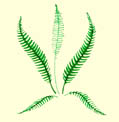The Fernhurst Society
Newsletter no 48, November 2016
A Peep into the Past
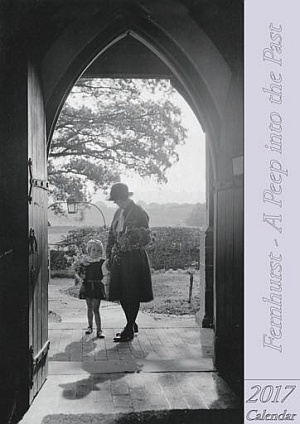 The Fernhurst Centre’s 2017 calendar features
exclusively photos from our Fernhurst Archive (see
Christine Maynard’s ‘Aaaah moment’ on page 7).
The Fernhurst Centre’s 2017 calendar features
exclusively photos from our Fernhurst Archive (see
Christine Maynard’s ‘Aaaah moment’ on page 7).
The Calendar is now on sale in the Fernhurst Centre and Fernhurst Post Office at £6.50 a copy or 3 Calendars for £18.
The Centre and Post Office also have packs of Christmas cards by local artists.
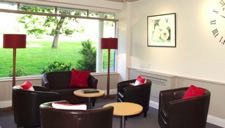
The Centre has recently reopened following refurbishment. Do drop in for a tea or coffee (and some delicious home-made cake) or to pick up a leaflet on the wonderful courses they run there and find out about the local groups that meet there.
The Fernhurst Centre, Crossfield, Fernhurst
Membership Subscriptions due January 2017 – New Gift Aid Form
Your membership subscriptions support the Fernhurst Society’s programme of events, our website http://www.fernhurstsociety.org.uk and the work of the Fernhurst Archive (open to the public Tuesday afternoons 2.30pm – 5.00pm). We are a registered charity and HMRC counts your subscription as a donation – making it eligible for Gift Aid. Gift Aid allows UK charities to claim back 25p for every £1 donated by UK Income Tax or Capital Gains Tax payers. The Gift Aid rules have changed so we are sending out a new Gift Aid Declaration Form with the membership renewal requests.
We very much hope that if you are such a UK tax payer you will complete our new separate gift aid form; boosting the value of the subscription by a quarter and supporting our programme of walks and talks, website and the work of the Fernhurst Archive.
Dates for your diary
| Thu 24 Nov 2016 Village Hall 7pm for 7.30pm NOTE EARLIER START |
AGM and Illustrated Talk: Women in the First World War Lynne Taylor Gooby, ex Head of the Royal School, will talk on the role of women in WW1 with special reference to some women from the Haslemere area. |
| Thu 23 Feb 2017 Village Hall 7.30pm for 8pm |
Secrets of the High Woods – Illustrated Talk Mark Seaman will tell how the high woodland between Petersfield and Arundel revealed it secrets in this South Downs project; including a long-lost Roman Road, numerous medieval deer parks and a tapestry of ancient farm fields. You may have seen the project in the News in the Summer of 2016. A mix of archaeology, archive research and oral history. |
| Sun 9 April 2017 Meet at Crossfield Car Park 1.30pm |
Secrets of the High Woods - Walk Mark Seaman will guide us on a Secrets of the High Woods walk showing us how to recognise some of the woodland features that the High Woods project uncovered. |
| Thu 27 April 2017 Village Hall 7.30pm for 8pm |
History minus the Boring Bits – Illustrated Talk Talk by Susan Howe. |
| Sun 21 May 2017 Recreation Ground from 12.30pm |
Fernhurst Revels |
| Date to be announced |
A Bob Smalley meander – Walk Bob’s walks are so interesting and popular that we’ve asked him to do another one. He’s currently scratching his head thinking of another new direction for us all. (Bob’s report of Tillington to Lodsworth on page 6 gives you a good flavour of what you might expect!) |
| Sat 9 – Sun 10 Sept 2017 |
Fernhurst Furnace Open Weekend The remains of Fernhurst Furnace are some of the best preserved of all Sussex Weald ironworking sites. This is always a great weekend of activities, usually with a living history society and the Sealed Knot in attendance. Admission by donation. All donations go to the charity set up to preserve this special site. http://www.fernhurstfurnace.co.uk |
| Sun 24 Sept 2017 Crossfield Car Park 1.30pm |
Petworth Park - Walk Guided walk led by Henry Wakeford of Petworth - taking in Petworth Park from prehistory onwards, Henry VIII's hunting lodge, the WW2 encampment, the water source for the house, the common enclosed within the park and the buildings that were pulled down to make way for Capability Brown's grand scheme. |
| Thu 26 Oct 2017 Village Hall 7.30pm for 8pm |
Talk by Robin Ellks, Kingsley Green representative on the Fernhurst Archive Team Subject of talk will be announced. |
| Thu 30 Nov 2017 Village Hall 7pm for 7.30pm NOTE EARLIER START |
AGM and Talk Subject of talk will be announced. |
Reviews of Fernhurst Society events
April 2016 - Talk: Work of the Weald and Downland Museum
Julian Bell, Curator of the Weald and Downland Museum, explained how the Museum dismantles and stores a building for restoration using a dairy and scalding house from the early 19th century as an example. The two derelict grade II buildings were part of the Eastwick Estate. Still in their original positions, they sat in the garden of a housing estate bungalow in Bookham, Surrey.
Heating water for cleaning and any activity that required heat took place in the scalding house whereas the dairy was kept cool for the storage of milk and milk products.
Although the buildings had tiled roofs, they had previously been thatched and each surrounded by a ring of cobbles (to prevent water dripping from the thatch eroding the surrounding soil). Archive documents for the sale of the estate in 1831 showed that the dairy and the scalding house were linked by a thatched walkway (with no sides).
Some of the flagstone floor to the dairy and scalding house had been deliberately incised with VV, a protective mark to ward off evil spirits. VV stands for Virgo Virginia (Virgin of Virgins) referring to Mary mother of Jesus. Animal bones were buried beneath the incised flagstones.
The gothic style wooden doors and windows were in relatively good condition, as was the exterior brickwork. The interior brick skin was largely rubble and collapsed. Each exterior brick, piece of timber and flagstone has been numbered for reconstruction at the Museum using beautifully drafted plans and elevations.
Inside the scalding house there was a 1930’s cast iron stove, behind which was a 1961 newspaper. The buildings were used for different purposes up until the 1960s and then as sheds by the bungalow owners. A 1940’s toy truck also made its way to the Museum.
Currently the Museum is storing 15 buildings awaiting re-erection. Julian estimated it would cost around 140,000 to re-erect the dairy and scalding house.
Elaine Ireland

In the garden the dairy looked like this
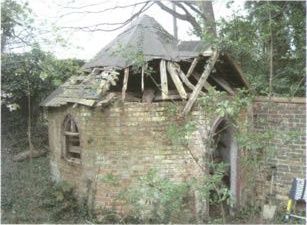
The scalding house looked like this
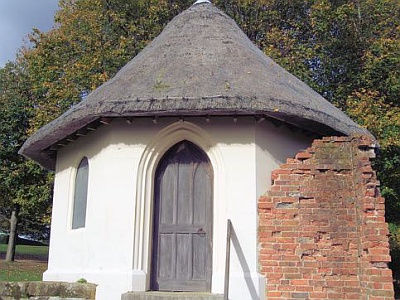
Once restored the dairy will look something like
the one above in the grounds of Battle Abbey.
May 2016 - Walk: The Rother Valley
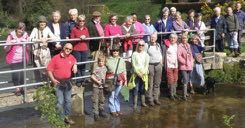 Bob Smalley did us proud again -
leading a wonderful walk along the
Rother Valley taking in sections
never seen before by our real
locals such as Kathleen Bird.
We walked from the National
Trust’s Woolbeding House, past
Stedham Mill, Stedham Hall and
St James’ Church back to
Woolbeding Bridge, taking in
glorious sunshine, wonderful
landscape and the beautiful stone
buildings by the river.
Bob Smalley did us proud again -
leading a wonderful walk along the
Rother Valley taking in sections
never seen before by our real
locals such as Kathleen Bird.
We walked from the National
Trust’s Woolbeding House, past
Stedham Mill, Stedham Hall and
St James’ Church back to
Woolbeding Bridge, taking in
glorious sunshine, wonderful
landscape and the beautiful stone
buildings by the river.
Many thanks to Peter Taylor for the photos
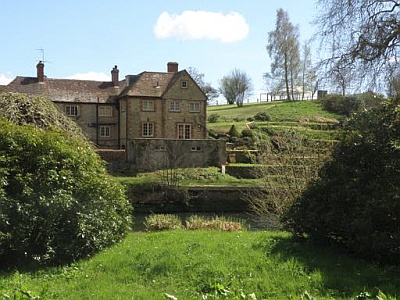
Stedham Mill
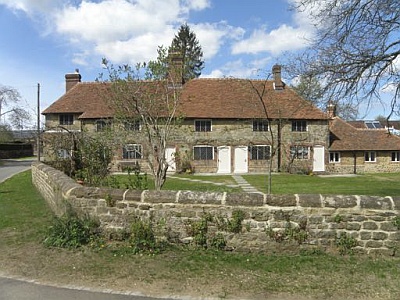
Building of local greensand stone with typical Sussex
hipped roof and windows snuggling under the eaves.
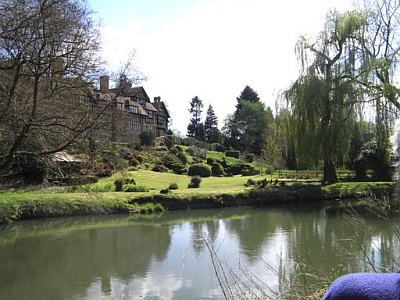
Stedham Hall comes into view

The Medieval Woolbeding Bridge
July 2016 - Walk: A military camp and special spot for botanists & butterfly lovers
Led by Pamela Lee, we learned how our government requisitioned Bramshott Common during the First World War for Bramshott Military Camp. Canadian soldiers were housed in wooden huts and a little corrugated iron tin town grew up with a café, openair theatre, post office and grocer’s shop. A 600-bed military hospital was built nearby. There are a great number of Canadian WW1 soldiers buried in the local church, many of whom were victims of the 1918 Spanish flu.
Canadian solders were again camped at Bramshott in the Second World War. Their contribution was remembered with the avenue of maple trees alongside the A3 and a memorial on the Common.
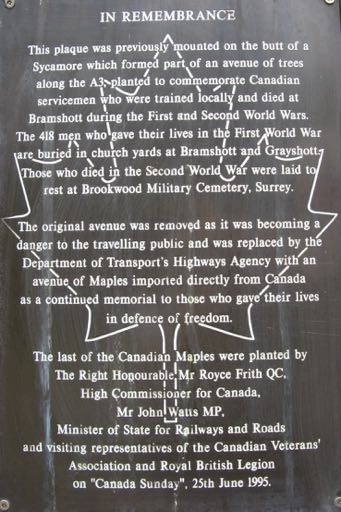
Before WW1 Bramshott Common was a mixture of
farmland and true common
where locals could collect
wood and bracken for home fires. During the war
children collected acorns to make acetone which was
needed for the
manufacture of cordite
(replacement for gunpowder as a propellant for
guns).
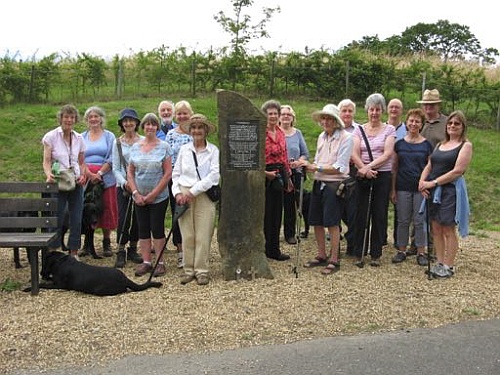
The Canadian Memorial on Bramshott Common– Pamela Lee, the walk leader, is
standing
immediately to the left of the memorial
Now, Pamela is a natural historian so along the route she alerted us to the numerous butterflies and different plants that you can find on the Common.
For you naturalists, here’s a taste of some of the
flora and fauna Pamela pointed out for us:
Butterflies
Lemon Blue Butterfly,
Silver-washed Fritillary,
Small Skipper,
Tortoiseshell Butterfly,
White and Black Spotted Butterfly
Plants
Carline Thistle, Centurea, Cinquefoil, Common
Agrimony, Daboecia Cantabrica, Enchanters
Nightshade, Eyebright, Greater Birds Foot Trefoil,
Marsh Thistle, Purple Betony, Tormentil, Wild sage,
Yellow Loosestrife
Elaine Ireland
Write for us…
If you’d like to submit an article and/or a photograph for the newsletter, please contact Elaine via enquiries@fernhurstsociety.org.uk
We can’t guarantee that we’ll publish it but we’d like to have your contributions on village life (past and present), local nature, walks, buildings, customs, memories and folklore whether you’re 5 or 95.
August 2016 - Walk: Oh Pooh!!!!!!!
Bob Smalley’s own description of the walk he led.
It always rains when the children are on school hols
but not so on the 21st August when the sun shone on
the mighty band of FernSoc walkers.
The walk was billed to start at Tillington Church and end at Lodsworth Larder so we all collected at Crossfield car park and somewhat reminiscent of the cartoon ‘Whacky Races’ made our way to Tillington village. Ten minutes spent in the church was a reward in itself, so full of local history.
We wandered through the back roads of the village and through the cemetery, more history. No one decided to stay, which was a blessing.
Onwards into the sunny Sunday afternoon, the view of the South Downs in both directions was breath taking. Ever onwards, through the vines growing on the south facing slopes, to Pitshill House.

Now, Lord Cowdray’s brother got really fed up with the masses walking passed his dining room window whilst he was having his Sunday lunch so he asked for the footpath to be diverted. Eleven, yep, 11 years later someone saw the sense in this so WE had a delightful walk along the top of the ridge past the stables and the effluent digester.
We thought of popping in for a cuppa but were a bit pushed for time.We continued along the ridge finding our way to River, delightful, and then into the valley, at the bottom of which was Eel Bridge under which runs a stream !!!!!!!
 Oh Pooh sticks…adults always revert to type… such
simple pleasures.
Oh Pooh sticks…adults always revert to type… such
simple pleasures.
Onwards and literally upward to Lodsworth Well, I’m
not sure that the 1ton bag of sand next to it
engendered a feel for Lodsworth’s history.
Our day really culminated at Lodsworth Church and you may have guessed, the grave of E. H. Shepard, the illustrator of A A Milne’s books of ‘Winnie the Pooh’.
What a great day we had, sunshine, the Sussex countryside, and of course not forgetting… Pooh Sticks!!!!!!
Bob Smalley
October 2016 - Talk: Loseley - the first 500 years
An illustrated talk on Loseley Park was given by the head guide, Jennifer Nicholas, and titled ‘The First 500 Years’ giving a lovely impression of the continuity of the place. It turned out that the continuity of inheritance was frail as the male line died out and inheritance went through the female line on several occasions.
It also involved sensibly changing the family’s religion in the reign of Henry VIII to ensure that the number of royal appointments were not reduced along with losing one’s head for being a Catholic and the double barrelling of the name from More to More-Molyneux where the ‘x’ is pronounced!
Although there was unfortunately a lack of pictures of the beautiful garden, house and the furniture (the purchase of which had contributed to the family’s considerable debts in earlier centuries), there were a great number of the family portraits principally of aged bearded men of power, wisdom, presence and authority.
Judith Turner
News from the Fernhurst Archives
archives@fernhurstsociety.org.uk
The ‘aaah’ moment
The ‘aaah’ moment arose when we looked at the delightful photo of the Girl Guide leader with a little girl, both holding flowers and framed by the church porch!
That picture, taken in 1933, was the instant choice for the cover of the Fernhurst Centre’s 2017 calendar when Pauline and Les Colcutt came to the Archive to choose a selection of photos from the extensive Archive collection.
Some will not have been seen widely before, such as the photos of the Red Lion taken 50 years apart, but still instantly recognisable today. Keen eyes will have spotted that the door of the Post Office is facing the main road. It was moved during the war after an American tank driver took the corner dangerously fast and nearly ended up in the Post Office.

The Post Office on the right on this Revels day – before its encounter with an American tank
An interesting sideline on the October picture of Cooksbridge Mill was that you could have the postcard with the horse and cart to add atmosphere to the shot or without. Many postcards in the early 1900s came with different features. The Kingsley Green photo (December) shows how vastly the hamlet has changed. Many houses were built in the 1920s and 30s and in the 1960s Roundleaze, which stood on the corner of Marley Lane where the Haslemere-bound bus shelter now stands, had to be demolished to make way for road straightening and widening.
Christine Maynard
A tip for the Horticultural Society?
In 1830 John Cameron, Steward to Mr Poyntz, the owner of the Cowdray Estate, was called to the House of Lords Select Committee on the Poor Laws to answer questions about poverty in Farnhurst (Fernhurst) in which the estate owned 895 acres of woodland. Mr Cameron explained local employment:
Cutting Wood affords the greatest Part of the Employment. In the Winter Season there are more employed in the Woods than in any other Part.
…and his solution to increasing local production of food within the woodland:
In the Parish of Easebourne, and in Lodsworth, Farnhurst, Linchmere, Ingershall, and some Part of Ambersham, I have allowed the People to plant Potatoes between the Trees, and this Year they have grown upwards of 5,000 Bushels* of Potatoes; the Year before they grew 4,000; the Year before that they grew 3,000; and the first Year they grew not above 1,000; because many of them would not try it in the first place, but after having seen others try it and succeed, they were sorry they had not done it themselves; and those Potatoes have enabled many of those Men to fatten their Pigs and so on, leaving a great Surplus for their Families.
I do not allow them to go too near the Trees, otherwise they might injure them; and therefore they cannot plant above Half the Ground.
When the Trees are planted. I plant them in Rows to accommodate them to plant Potatoes between.
* 1 bushel is equivalent to 8 gallons (36.4 litres).
Mr Cameron also gives a several page account of local farming at the time - a paper copy of which is available for viewing at the Fernhurst Archive. Source: http://www.british-history.ac.uk/lordsjrnl/ vol63/pp556-561
Elaine Ireland
The Fernhurst Archive
archives@fernhurstsociety.org.uk
Open Tuesdays between 2.30pm and 5pm, we’re upstairs in the Village Hall (side entrance). We have a substantial archive of photographs and documents and some artefacts. We welcome enquiries on local history, buildings, archaeology and genealogy in person or by email.
If you wish to visit, do contact Christine Maynard beforehand either by phone 653663 or email – archives@fernhurstsociety.org.uk - it helps us to have the relevant information ready for you.
Archive Group meeting
The Fernhurst Archive is one of many local villages with similar problems that were worth discussing with other groups rather than everyone trying to reinvent their own wheel . Realising this, it was decided to host a meeting for as many representatives from different groups as we could encourage to join in. And they did – from Headley to Tangmere, Liphook to Chiddingfold and many inbetween.
Chaired by Fernhurst, our Archive team opened each heading such as acquisitions, cataloguing, storage, scanning, funding, publicity, websites and social media with a short description of how we did it and the problems or successes and then opened the floor to all others who were not slow in coming forward.
There were also short presentations from the West Sussex Records Office and on the Community Archives and Heritage Group.
The discussions were useful and successful and it is probable that a similar event will be run again in a year or two.
Judith Turner
The Fernhurst Society Website
http://www.fernhurstsociety.org.uk
We also store a lot of historical information on
our website including the Fernhurst census
returns up until 1901 (we’re currently working on transcribing the 1911 census).
The United Benefice of Fernhurst, Lynchmere and Camelsdale churches
The Fernhurst Vicar, Rev Nick Haigh, is now caring for three congregations in the area. Michael Tibbs of Lynchmere tells us this is not the first time in the history of the churches that they have been linked.
A new chapter as churches link up… So ran the headline in the Haslemere Herald of the 29th September 2016. A new chapter, yes but from a very old book stretching back over the centuries. In 1580, Andrew Talpot was licenced to serve the cure of Lynchmere, during the same year he was also licenced to serve the parish of Fernhurst; later that century John Bennet was licenced to Lynchmere and two years later to Fernhurst. Two centuries later we find that James Bailey also served both parishes.
We then jump to the last century when Frank Jewel Evens became Vicar of Lynchmere in 1906; by this time Camelsdale had grown owing to the supply of cheap bricks from Hammer Brick works. Camelsdale was split between Lynchmere and Fernhurst, the boundary running down Border – now School road.
History is inclined to repeat itself and go round in circles. In 1906 when Frank Jewel Evans became Vicar of Lynchmere, he was also made Curate of Fernhurst so that he could look after the spiritual needs of the whole of Camelsdale. In our archives there is a copy of what may have been the last ‘Fernhurst, Lynchmere and Camelsdale’ Parish Magazine in 1913.
By the 1930s Camelsdale had a Priest in Charge of what was called a Conventual District, but there was great agitation that Camelsdale should be made a separate ecclesiastical Parish. Lynchmere played its part in this and it came to fruition in 1936.
Things changed again in 1997 when John Musson was instituted as Vicar of the Combined Benefice of Lynchmere and Camelsdale. So there we were back where we were nearly 100 years before. This is what the Foreign Office calls the ‘Status Quo Ante’.
So we come to the present. On Tuesday 4th October there was a joyful celebration to welcome our new Priest in Charge. Eucharist was held in St. Peter’s with the Licencing of the Vicar of Fernhurst, the Rev. Nick Haigh, as Priest in Charge of Lynchmere and Camelsdale by the Bishop of Horsham, the Rt. Rev. Mark Sowerby, and the Archdeacon of Horsham, the Ven. Fiona Windsor.
Michael Tibbs
